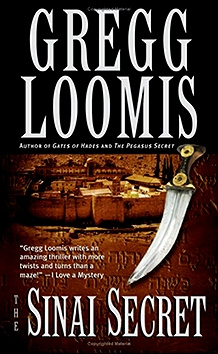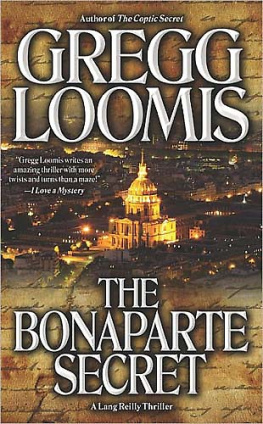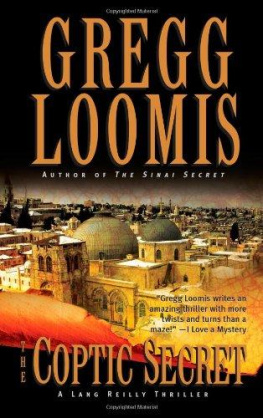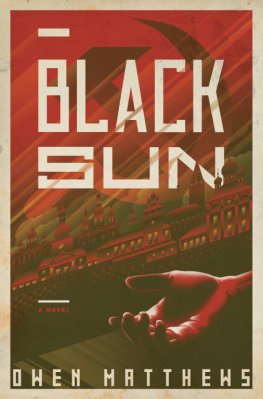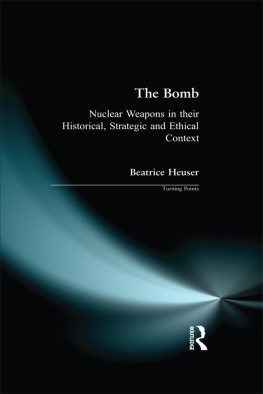Gregg Loomis - The Sinai Secret
Here you can read online Gregg Loomis - The Sinai Secret full text of the book (entire story) in english for free. Download pdf and epub, get meaning, cover and reviews about this ebook. year: 2011, publisher: DP, genre: Detective and thriller. Description of the work, (preface) as well as reviews are available. Best literature library LitArk.com created for fans of good reading and offers a wide selection of genres:
Romance novel
Science fiction
Adventure
Detective
Science
History
Home and family
Prose
Art
Politics
Computer
Non-fiction
Religion
Business
Children
Humor
Choose a favorite category and find really read worthwhile books. Enjoy immersion in the world of imagination, feel the emotions of the characters or learn something new for yourself, make an fascinating discovery.
- Book:The Sinai Secret
- Author:
- Publisher:DP
- Genre:
- Year:2011
- Rating:3 / 5
- Favourites:Add to favourites
- Your mark:
- 60
- 1
- 2
- 3
- 4
- 5
The Sinai Secret: summary, description and annotation
We offer to read an annotation, description, summary or preface (depends on what the author of the book "The Sinai Secret" wrote himself). If you haven't found the necessary information about the book — write in the comments, we will try to find it.
The Sinai Secret — read online for free the complete book (whole text) full work
Below is the text of the book, divided by pages. System saving the place of the last page read, allows you to conveniently read the book "The Sinai Secret" online for free, without having to search again every time where you left off. Put a bookmark, and you can go to the page where you finished reading at any time.
Font size:
Interval:
Bookmark:
"I'll take that, Mr. Reilly."
Lang turned slowly. Leather Jacket and another man stood just inside the door. Each held an automatic obscured by a silencer.
The two men were a good five feet apart. No chance Lang could draw the SIG Sauer from its holster and fire before at least one of the intruders could shoot.
Lang slowly raised his hands, his fingers manipulating the envelopes so that one was squarely behind the other. "What can I do for you, gentlemen?"
Leather Jacket motioned with his weapon. "The envelope you have in your hand, Mr. Reilly, put it on the counter and slide it towards me."
The question was whether these two intended to take what they had come for and leave or make sure Lang did not trouble them further. The silencers on each gun did not suggest a happy ending. It was unlikely a man would risk carrying something that bulky if he had no intention of using it.
If Lang was going to do something, now seemed about the right time.
But what?
PROLOGUE
Mount Horeb Sinai Peninsula March 1904
Sir W. M. Flinders Petrie was astonished but certainly not pleased by his discovery.
His expedition had been funded by the Egypt Exploration Fund for the purpose of revisiting and mapping the area of mining activity by the ancient Egyptians between the gulfs of Suez and Aqaba. Like so many explorers before him, he had found something quite different from the object of his search.
Although this was supposedly Mount Sinai, the mountain from which Moses had brought down the Ten Commandments, Petrie had no particular expectations. The place was in the area he was surveying, so the expedition had struggled up the sharp outcrop to its summit. Instead of more craggy red sandstone boulders, scrubby brush, and a surplus of scorpions, they were viewing something totally unexpected.
Jutting out from what was clearly a man-made cave were remnants of walls of ancient handmade brick. The southern side of the walls had long ago been abraded by sand blown by millennia of wind, the consistent gritty, hot breeze Petrie had come to think of as the breath of the desert. The northern side still displayed a patina of the painted plaster that had once covered the crude bricks. In the plaster were inscriptions, hieroglyphics that Petrie recognized as possibly dating back to the Twelfth Pharaonic Dynasty of about 2600 b.c.
Long before Moses.
This presented a problem.
The articles of association of the sponsoring Egypt Exploration Fund were quite clear: One of its objectives was excavation and exploration for the purpose of confirming or elucidating the Old Testament. This was the mountain where Moses had spoken with God in the form of a burning bush; from which he had brought down not one, but two sets of commandments; and at the base of which he had burned the idolatrous golden calf.
Petrie's discovery was tantamount to betraying his friends and sponsors, something no English gentleman could countenance.
Making the find public would certainly lose future financing from the fund. It could well lead to disgrace, even his loss of privileges at the Explorers' Club in Mayfair.
He wished he had never seen this wretched mountain.
Still, he and his exploration team were here, and not even investigating the site would be wasteful indeed.
By sunset the shifting sands had yielded an impressive collection of tablets, statues, and tools typical of a temple. Petrie was confident the next day would reveal an altar and other evidence of worship of the oft-depicted Hathor, the goddess of love, tombs, gold, and song, and from whose milk pharaohs gained immortality. There was no doubt about the god pictured: No other deity had cow horns and a solar disk on its head.
By the time dinner was over and the native porters had erected tents for him and the three other Englishmen,
Petrie had decided to simply submit his findings and let the Fund decide what use to make of them.
A bother, that. He had planned to publish an account of this exploration himself.
By the next afternoon loose sand had been removed from a number of halls and chambers. Reliefs of various pharaohs and their favorite wives, sons, and chamberlains were uncovered, but not the main altar.
What had been discovered was a series of rectangular and round holes carved into the sandstone, each hole larger than a bathtub. Petrie had never seen anything quite like them, and their possible function eluded him. The discovery of a metallurgist's crucible and perhaps several pounds of an unidentified white powder beneath a stone floor was equally puzzling. Perhaps it was the strange object frequently mentioned in the inscriptions on the walls and surrounding stelae. He certainly had no other idea what the word referred to. He had never seen it before. Even more mysterious was why a crucible would be in a temple in the first place.
It was referred to again in a portrayal of Anubis, the jackal-god who led the deceased into the afterlife. The animal was lying on an ark while the pharaoh Amenhotep presented a conical object. The inscription stated something about giving gold and rejoicing mouths.
Another search revealed no gold, only the enigmatic white powder.
Like any competent archaeologist, Petrie recorded his findings, completed his excavation (without locating the missing altar), and continued the survey he had been sent to complete.
Having apparently reached some sort of peace with the Fund, he published a short book on his exploration, Ancient Egypt and Ancient Israel, in 1910. His discoveries might have caused reactions in the academic world had the real discovery not been overshadowed by the storm clouds of two world wars.
Again, like many explorers, he had set in motion forces he could not have imagined. No one in early twentieth-century Europe could have.
ONE
Stift Melk an der Donau (on the Danube)
Austria
The present
Joseph Steinburg, Ph.D., stood at the two-story entrance facing the afternoon sun. In front of him, the hill on which the first part of the monastery had been built in the tenth century dropped precipitously into the rushing gray waters of the Danube. Behind him was the library. Fifty-foot-high book-lined walls ran the three-hundred- foot length of the huge room.
From the chapel below came the vesper chants of the thirty or so monks who still occupied that part of the baroque abbey not presently used as a parochial school. He paid no attention, if, in fact, he even heard.
Were it not for the boat pushing barges upstream and the cars humming along the highway across the river, Steinburg could have been anywhere in time within the last millennium.
He wasn't thinking about that, either.
He could only ponder the strange discovery that had occupied him for the last two days.
A year ago the abbey had begun the awesome task of creating a computer index of the library, including the two thousand-plus volumes that dated back to the ninth through the fifteenth centuries. Last week one of the graduate students had discovered a number of bound parchments in ancient Hebrew, perhaps misplaced in the panic to hide all things of value that ensued when, in 1683, Kara Mustafa and his two hundred thousand Turks laid siege to Vienna, just fifty miles to the east. Although the Turks were forced to withdraw only three months later, these documents had, most likely, not been returned to their proper place, remaining with what were at the time current religious writings. The Church had asked Steinburg, part-time archeologist and full-time professor of ancient Hebrew history, to translate and date the documents.
From the heavy parchment and ink, Steinburg guessed the physical pages themselves could be as old as Melk. But the events they described were older, much older. The unusual syntax, phrases borrowed from pharaonic Egyptian, indicated that someone had painstakingly translated a chronicle from, say, 1500 to 1200 b.c . Or, to be politically correct, b.c.e., before the Common Era. In any event, before Hebrew itself was recognizable as a written language.
Next pageFont size:
Interval:
Bookmark:
Similar books «The Sinai Secret»
Look at similar books to The Sinai Secret. We have selected literature similar in name and meaning in the hope of providing readers with more options to find new, interesting, not yet read works.
Discussion, reviews of the book The Sinai Secret and just readers' own opinions. Leave your comments, write what you think about the work, its meaning or the main characters. Specify what exactly you liked and what you didn't like, and why you think so.

